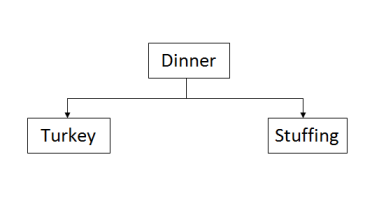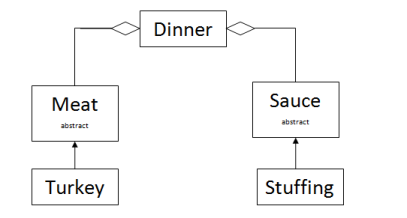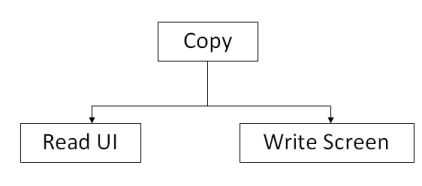CSC/ECE 517 Fall 2009/wiki3 5 SD
Dependency inversion principle
Introduction
The objects in our software should not get into a hierarchy where some objects are in the top-level ones, and dependent on low-level objects. Changes in low-level objects will then ripple-through to top-level objects which makes the software very fragile for change. It is always required that 'top-level' objects be very stable and not fragile for change, therefore the dependencies need to inverted.The point of dependency inversion is to make reusable software.Instead of two pieces of code relying on each other, they rely on some abstracted interface. Then either pieces can be reused without the other.
In conventional application architecture, lower-level components are designed to be consumed by higher-level components which enable increasingly complex systems to be built. In this composition, higher-level components depend directly upon lower-level components to achieve some task. This dependency upon lower-level components makes applications rigid, fragile and immobile. Goal of Dependency inversion principle is to decouple the high-level components from low-level components.
What is Dependency inversion principle?
Dependency inversion principle states that:
- High-level modules should not depend on low-level modules. Both should depend on abstractions.
- Abstractions should not depend upon details. Details should depend upon abstractions.
In conventional architecture, higher-level components depend upon lower-level components as depicted in the following diagram:1
http://4.bp.blogspot.com/_rO0OuTtGb2Y/SVgyGeeYzwI/AAAAAAAAATM/NPsuTSArKIg/s400/DIP1.png
In this diagram, component A depends upon component B, which in turn depends upon component C. Due to these dependencies, each of the higher-level components is coupled with the lower-level components.
The goal of the Dependency Inversion Principle is to decouple higher-level components from their dependency upon lower-level components. This may be achieved by creating interfaces as part of the higher-level component package which define the component’s external needs. This allows the component to be isolated from any particular implementation of the provided interface, thus increasing the component’s portability. The following diagram illustrates this relationship:1
http://4.bp.blogspot.com/_rO0OuTtGb2Y/SVgyGil3HQI/AAAAAAAAATU/lezX76UCH7Q/s400/DIP2.png
In this diagram, component A provides an interface which defines the services it needs. Component B satisfies this dependency by implementing the interface. The same relationship is additionally shown for components B and C. Take special note that the interfaces are packaged together with the higher-level components and are defined in terms of the higher-level component’s needs, not the lower-level component’s behavior. It is this association of the interface with the client component which logically inverts the conventional dependency flow.
Examples
Example 1:
Consider the following block diagram. Here the higher level class, Dinner depends upon the lower level classes Turkey and Stuffing.
Now, if we want to make Chicken instead of Turkey for dinner then the Dinner class becomes useless since it cannot be used in any other context other than making Turkey and Stuffing.
Notice that the module containing the high level policy, i.e. the Dinner() module, is dependent upon the low level detailed modules that it controls. (i.e. Turkey() and Stuffing()). If we could find a way to make the Dinner module independent of the details that it controls, then we could reuse it freely.
Consider the modified class diagram shown here:
Here we have a Dinner class which contains an abstract Meat class and an abstract Sauce class. Now we can have a loop within the Dinner class that gets ingredients from its abstract classes. Yet the Dinner class does not depend upon the “Turkey” nor the Stuffing class at all. Thus the dependencies have been inverted. Now we can reuse the “Dinner” class, independently of the “Turkey” and the “Stuffing” class.
Example2:
Consider the following block diagram. The higher level module Copy() depends upon lower level modules ReadUI() and WriteScreen().
The code for the above diagram would look like this:
Void Copy
{
ReadUI()
Writescreen()
}
Notice that the two lower modules ReadUI() and WriteScreen() are reusable where as the higher level module Copy() cannot be reused in any other context other than Reading from a UI and Writing to a screen. This is a little inconvinient because there might be some useful logic in Copy() that could have been used to say Write to a file instead to the screen.
By reversing the dependencies as shown below we can reuse the Copy() module:
class Reader
{
public:
virtual int Read() = 0;
};
class Writer
{
public:
virtual void Write(char) = 0;
};
void Copy(Reader& r, Writer& w)
{
int c;
c = r.Read()
w.Write(c);
}
Example 3:
Below is an example which violates the Dependency Inversion Principle. There is a manager class which is a high level class, and the low level class Worker. A new module has to be added to the application because in the company there are some new specialized workers employed.So, new class SuperWorker was created for this.Manager class is a complex one containing a very complex logic,and it has to be changed, in order to introduce the new SuperWorker.
Below are the disadvantages:
1.Manager class has to be changed(remember it is a complex one and this will involve some time and effort).
2.Some present functionality from the manager class might be affected.
3.Unit testing should be redone.
All these problems will take a lot of time to solve. Now it would be very simple if the application was designed following the Dependency Inversion Principle. That means the design has the manager class , an IWorker interface and the Worker class implementing the IWorker interface. So,to add the SuperWorker class ,all we have to do is implement the IWorker interface for it.
Conclusion
Index
- Separated Interface Pattern :This pattern reduces coupling by placing the interface definition in a separate package as the implementation.



